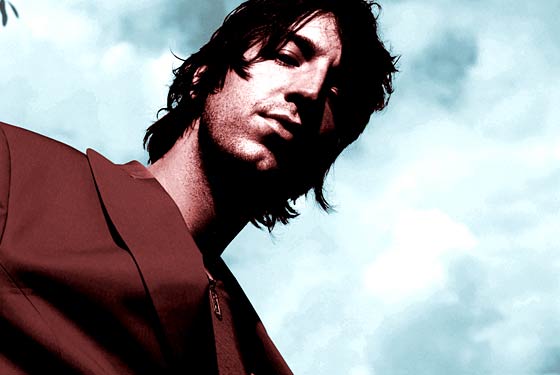
At the Bowery Ballroom last month, Joseph Arthur had a costume change before his encore and came out wearing a white suit, no shirt, and a big cross dangling around his neck. With tangled hair and a three-day beard, he looked like some mental-ward Evangelist, and then he started singing like one, too. Joined onstage by Michael Stipe, Arthur belted out his signature anthem “In the Sun,” with its rousing hook, “May God’s love be with you, always, always.” The crowd, a typical downtown assortment of 30-year-olds in hoodies and jeans, knew every word and lustily sang along, as if trying to atone for all those Sunday-school classes they blew off.
“I hate religion,” Arthur had told me a few days earlier, when we met at his loft in Dumbo. “But I do believe there’s some intelligence guiding this whole thing. You can call it Jesus or whatever you want.”
Onstage and on record, Arthur exudes a coolness that makes you think he could be world famous. And at one point in his career, he was marked for stardom. The mini-legend of Joseph Arthur goes like this: When he was a 25-year-old nobody working at a guitar shop in Atlanta (“They told me I was the worst employee in the history of the store,” he says), a demo tape of his made its way, via friends of friends, into the hands of Peter Gabriel, who invited him to record at his studio in England. This is, in certain music circles, the equivalent of being summoned to Rome to pray with the pope. Arthur went with proper humility. “There were all these major people there, like Joe Strummer. I thought they’d maybe let me play a little bass. But then Peter asked me to write some lyrics, and the next thing I know, I’m in there singing with him.”
It’s been almost ten years since, and Arthur’s career has proceeded fitfully. There’s been one constant, however: He has made consistently excellent rock music. His latest album, Nuclear Daydream, is his fifth, and it is a tutorial in finely textured songwriting. The tunes are generally slow to mid-tempo, built from simple chord progressions and driven by a powerful, versatile voice that blends bits of Jagger, Dylan, Bowie, and Stipe. Arthur’s lyrics tend to be blunt vignettes about the struggles of love and faith, and they do occasionally veer into solipsistic clichés. But because his delivery is so full bore, you find yourself helplessly singing along even to lyrics that might otherwise make you wince, such as “Woman, you make me feel / Woman, are you for real?” And though the sentiments are often bleak, Arthur takes such cathartic pleasure in expressing them that even the darkest moments contain a glimmer of hopefulness.
Arthur is a solo artist in the truest sense of the word. He plays nearly all the instruments on his albums, and after shuttling through a series of major and minor labels, he now operates his own record company, Lonely Astronaut. Fortunately, technology and the trajectory of the music business favor the solo practitioner. With a few thousand bucks of computer equipment, a lone dude like Arthur can construct homemade walls of sound that would blow what’s left of Phil Spector’s mind. You don’t need a band, except to tour, and not necessarily even then. Arthur used to go out on the road alone with an acoustic guitar and electronic sampling equipment. Such a lean operation gave him the best chance to make a living in a business where you can expect to be robbed by your own fans.
Even as he becomes an entrepreneur, Arthur remains singularly focused on making art. When I visited him at his loft, a barely postindustrial den that might as well be a stop on the F train for how loud it sounds going by, the floor was covered with kids’ drawings, several dozen of them. From across the room, they looked like a glorious Technicolor quilt, but up close, you could see that each little picture depicted a horrific scene—soldiers killing and raping, helicopters spewing gunfire. These had been produced by orphans at a refugee camp in northern Uganda, where Arthur had just visited to deliver art supplies and help the kids learn to draw. In the few days since he’d returned, he’d been on a creative binge himself, writing five new songs.
“It’s the first time in my life I’ve ever done anything like that,” he says of the trip to Uganda, “and it was totally amazing. These people have experienced so many horrible things, and yet we saw more joy there than you see on the streets of New York. Happy, you know, just to be alive. And the kids were ecstatic to make their own drawings and express what was inside of them. If that doesn’t inspire you as an artist, nothing will.”

BACKSTORY
In his years as a solo act, Arthur performed a strange twist on the one-man band. After looping a couple of layers of acoustic guitar through a “Jam Man,” he would sing with the mike in one hand while painting with the other. Earlier this year, he released a book of paintings, We Almost Made It, which features some of those works. A mostly instrumental CD accompanies the reproductions of Arthur’s spooky, primitive figures. The Vertigo Gallery in London exhibited Arthur’s works in February. Though his new bandmates have taken the place of the easel, there is still plenty of beauty onstage: Arthur’s bass player, Sybil Buck, has modeled for Nicole Miller, among others.
Nuclear Daydream
Joseph Arthur. Lonely Astronaut.